MKT00720: Report on Aldi Australia Marketing Analysis
VerifiedAdded on 2023/01/05
|16
|4212
|54
Report
AI Summary
This report provides a critical analysis of Aldi Australia's marketing strategies, examining its approach to the Australian market since its launch in 2001. The report begins with background information on Aldi, a German supermarket chain known for its low prices and competitive advantage. It then delves into Aldi's marketing strategies, including its product offerings, pricing strategies, store layout, and promotional activities, and how these align with the marketing mix and Porter's cost leadership strategy. The report also explores Aldi's value chain analysis, highlighting its primary activities and how they contribute to its competitive edge. The report identifies areas for Aldi's continued success in the Australian market. Finally, the report concludes with strategic marketing options for Aldi to maintain its success over the next decade, emphasizing partnerships, customer-focused stocking, retail focus, pricing adjustments, fresh food, store formats, and environmentally friendly practices. This report is an analysis of Aldi Australia's marketing strategies, competitive advantages, and future prospects.
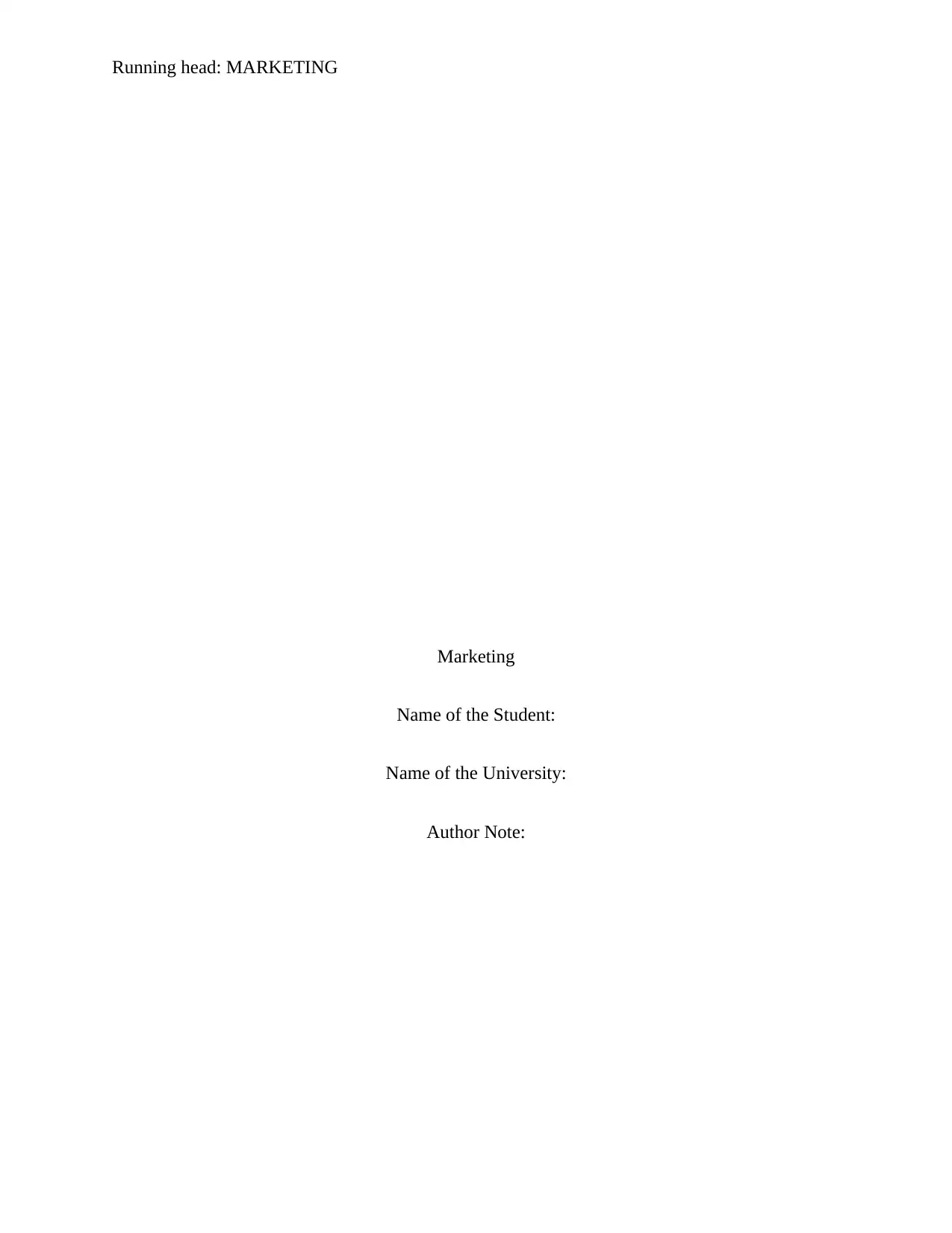
Running head: MARKETING
Marketing
Name of the Student:
Name of the University:
Author Note:
Marketing
Name of the Student:
Name of the University:
Author Note:
Paraphrase This Document
Need a fresh take? Get an instant paraphrase of this document with our AI Paraphraser
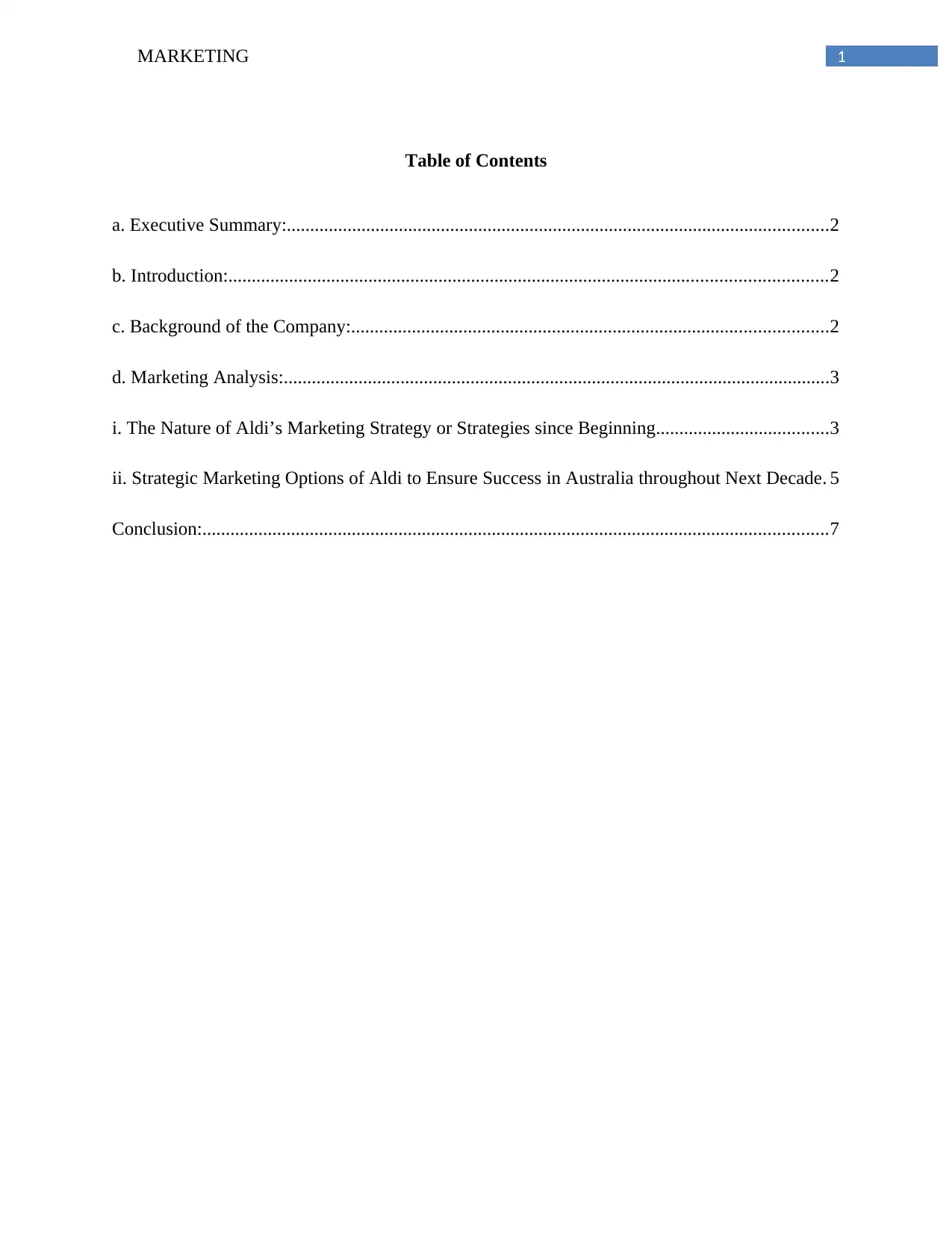
1MARKETING
Table of Contents
a. Executive Summary:....................................................................................................................2
b. Introduction:................................................................................................................................2
c. Background of the Company:......................................................................................................2
d. Marketing Analysis:.....................................................................................................................3
i. The Nature of Aldi’s Marketing Strategy or Strategies since Beginning.....................................3
ii. Strategic Marketing Options of Aldi to Ensure Success in Australia throughout Next Decade. 5
Conclusion:......................................................................................................................................7
Table of Contents
a. Executive Summary:....................................................................................................................2
b. Introduction:................................................................................................................................2
c. Background of the Company:......................................................................................................2
d. Marketing Analysis:.....................................................................................................................3
i. The Nature of Aldi’s Marketing Strategy or Strategies since Beginning.....................................3
ii. Strategic Marketing Options of Aldi to Ensure Success in Australia throughout Next Decade. 5
Conclusion:......................................................................................................................................7
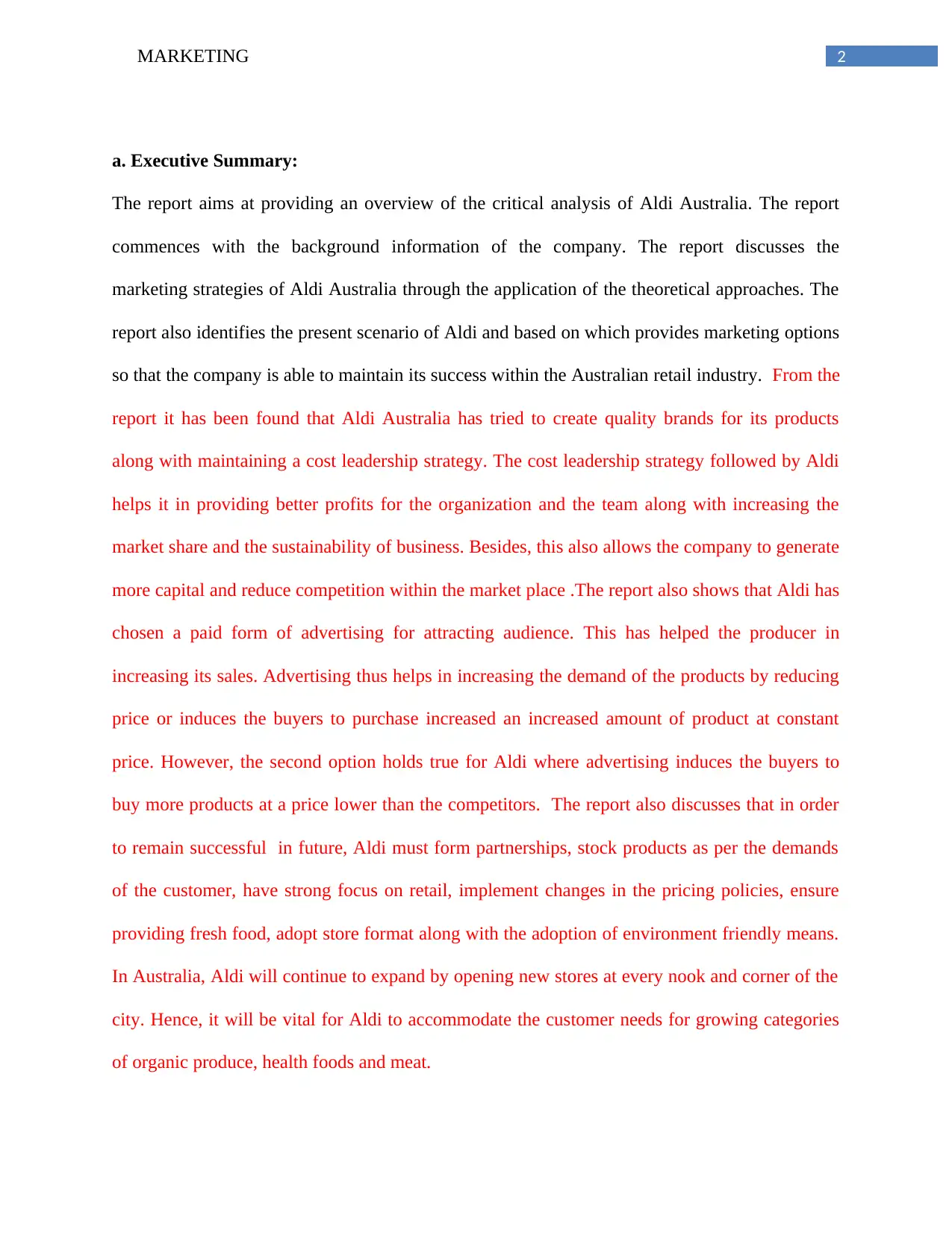
2MARKETING
a. Executive Summary:
The report aims at providing an overview of the critical analysis of Aldi Australia. The report
commences with the background information of the company. The report discusses the
marketing strategies of Aldi Australia through the application of the theoretical approaches. The
report also identifies the present scenario of Aldi and based on which provides marketing options
so that the company is able to maintain its success within the Australian retail industry. From the
report it has been found that Aldi Australia has tried to create quality brands for its products
along with maintaining a cost leadership strategy. The cost leadership strategy followed by Aldi
helps it in providing better profits for the organization and the team along with increasing the
market share and the sustainability of business. Besides, this also allows the company to generate
more capital and reduce competition within the market place .The report also shows that Aldi has
chosen a paid form of advertising for attracting audience. This has helped the producer in
increasing its sales. Advertising thus helps in increasing the demand of the products by reducing
price or induces the buyers to purchase increased an increased amount of product at constant
price. However, the second option holds true for Aldi where advertising induces the buyers to
buy more products at a price lower than the competitors. The report also discusses that in order
to remain successful in future, Aldi must form partnerships, stock products as per the demands
of the customer, have strong focus on retail, implement changes in the pricing policies, ensure
providing fresh food, adopt store format along with the adoption of environment friendly means.
In Australia, Aldi will continue to expand by opening new stores at every nook and corner of the
city. Hence, it will be vital for Aldi to accommodate the customer needs for growing categories
of organic produce, health foods and meat.
a. Executive Summary:
The report aims at providing an overview of the critical analysis of Aldi Australia. The report
commences with the background information of the company. The report discusses the
marketing strategies of Aldi Australia through the application of the theoretical approaches. The
report also identifies the present scenario of Aldi and based on which provides marketing options
so that the company is able to maintain its success within the Australian retail industry. From the
report it has been found that Aldi Australia has tried to create quality brands for its products
along with maintaining a cost leadership strategy. The cost leadership strategy followed by Aldi
helps it in providing better profits for the organization and the team along with increasing the
market share and the sustainability of business. Besides, this also allows the company to generate
more capital and reduce competition within the market place .The report also shows that Aldi has
chosen a paid form of advertising for attracting audience. This has helped the producer in
increasing its sales. Advertising thus helps in increasing the demand of the products by reducing
price or induces the buyers to purchase increased an increased amount of product at constant
price. However, the second option holds true for Aldi where advertising induces the buyers to
buy more products at a price lower than the competitors. The report also discusses that in order
to remain successful in future, Aldi must form partnerships, stock products as per the demands
of the customer, have strong focus on retail, implement changes in the pricing policies, ensure
providing fresh food, adopt store format along with the adoption of environment friendly means.
In Australia, Aldi will continue to expand by opening new stores at every nook and corner of the
city. Hence, it will be vital for Aldi to accommodate the customer needs for growing categories
of organic produce, health foods and meat.
⊘ This is a preview!⊘
Do you want full access?
Subscribe today to unlock all pages.

Trusted by 1+ million students worldwide
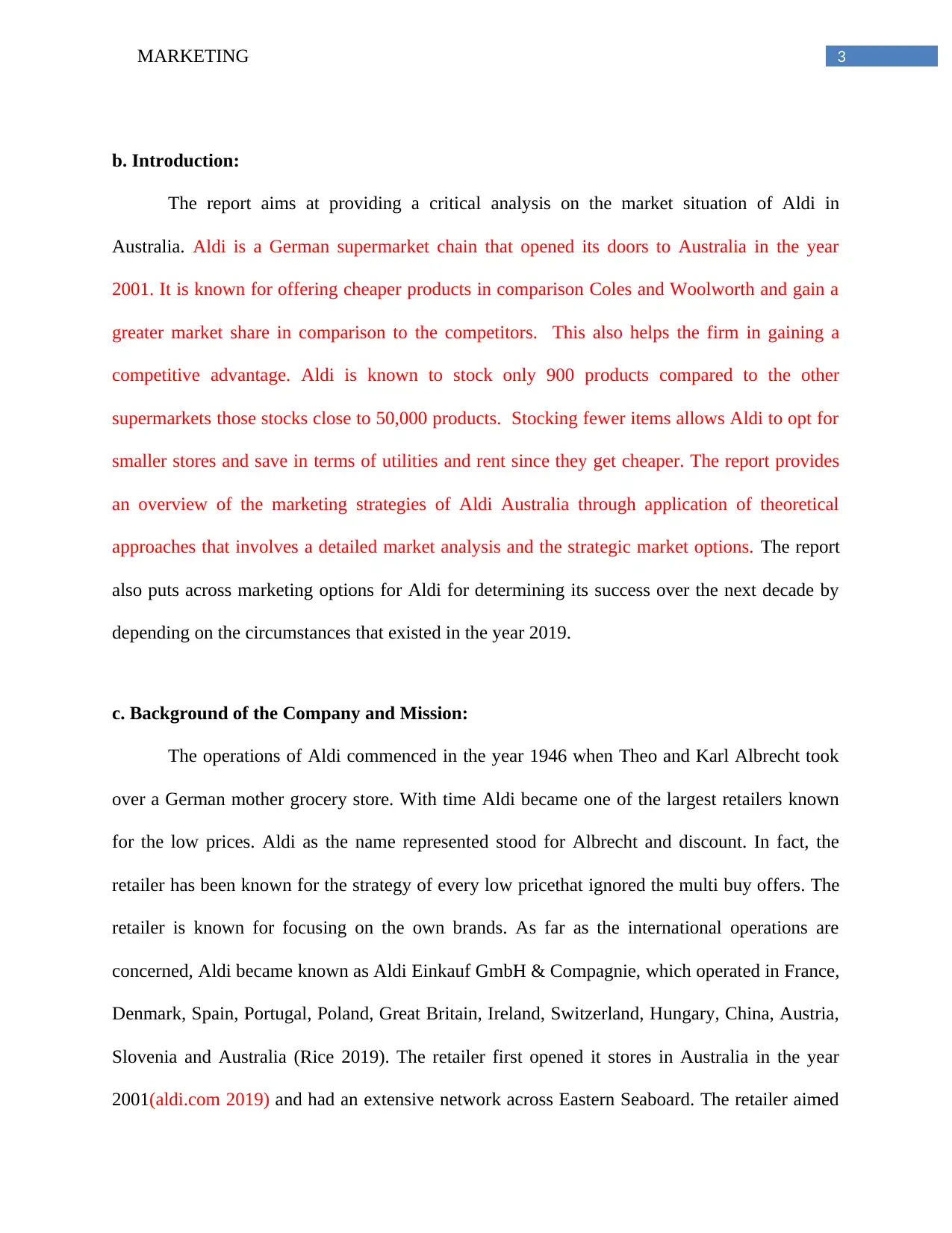
3MARKETING
b. Introduction:
The report aims at providing a critical analysis on the market situation of Aldi in
Australia. Aldi is a German supermarket chain that opened its doors to Australia in the year
2001. It is known for offering cheaper products in comparison Coles and Woolworth and gain a
greater market share in comparison to the competitors. This also helps the firm in gaining a
competitive advantage. Aldi is known to stock only 900 products compared to the other
supermarkets those stocks close to 50,000 products. Stocking fewer items allows Aldi to opt for
smaller stores and save in terms of utilities and rent since they get cheaper. The report provides
an overview of the marketing strategies of Aldi Australia through application of theoretical
approaches that involves a detailed market analysis and the strategic market options. The report
also puts across marketing options for Aldi for determining its success over the next decade by
depending on the circumstances that existed in the year 2019.
c. Background of the Company and Mission:
The operations of Aldi commenced in the year 1946 when Theo and Karl Albrecht took
over a German mother grocery store. With time Aldi became one of the largest retailers known
for the low prices. Aldi as the name represented stood for Albrecht and discount. In fact, the
retailer has been known for the strategy of every low pricethat ignored the multi buy offers. The
retailer is known for focusing on the own brands. As far as the international operations are
concerned, Aldi became known as Aldi Einkauf GmbH & Compagnie, which operated in France,
Denmark, Spain, Portugal, Poland, Great Britain, Ireland, Switzerland, Hungary, China, Austria,
Slovenia and Australia (Rice 2019). The retailer first opened it stores in Australia in the year
2001(aldi.com 2019) and had an extensive network across Eastern Seaboard. The retailer aimed
b. Introduction:
The report aims at providing a critical analysis on the market situation of Aldi in
Australia. Aldi is a German supermarket chain that opened its doors to Australia in the year
2001. It is known for offering cheaper products in comparison Coles and Woolworth and gain a
greater market share in comparison to the competitors. This also helps the firm in gaining a
competitive advantage. Aldi is known to stock only 900 products compared to the other
supermarkets those stocks close to 50,000 products. Stocking fewer items allows Aldi to opt for
smaller stores and save in terms of utilities and rent since they get cheaper. The report provides
an overview of the marketing strategies of Aldi Australia through application of theoretical
approaches that involves a detailed market analysis and the strategic market options. The report
also puts across marketing options for Aldi for determining its success over the next decade by
depending on the circumstances that existed in the year 2019.
c. Background of the Company and Mission:
The operations of Aldi commenced in the year 1946 when Theo and Karl Albrecht took
over a German mother grocery store. With time Aldi became one of the largest retailers known
for the low prices. Aldi as the name represented stood for Albrecht and discount. In fact, the
retailer has been known for the strategy of every low pricethat ignored the multi buy offers. The
retailer is known for focusing on the own brands. As far as the international operations are
concerned, Aldi became known as Aldi Einkauf GmbH & Compagnie, which operated in France,
Denmark, Spain, Portugal, Poland, Great Britain, Ireland, Switzerland, Hungary, China, Austria,
Slovenia and Australia (Rice 2019). The retailer first opened it stores in Australia in the year
2001(aldi.com 2019) and had an extensive network across Eastern Seaboard. The retailer aimed
Paraphrase This Document
Need a fresh take? Get an instant paraphrase of this document with our AI Paraphraser
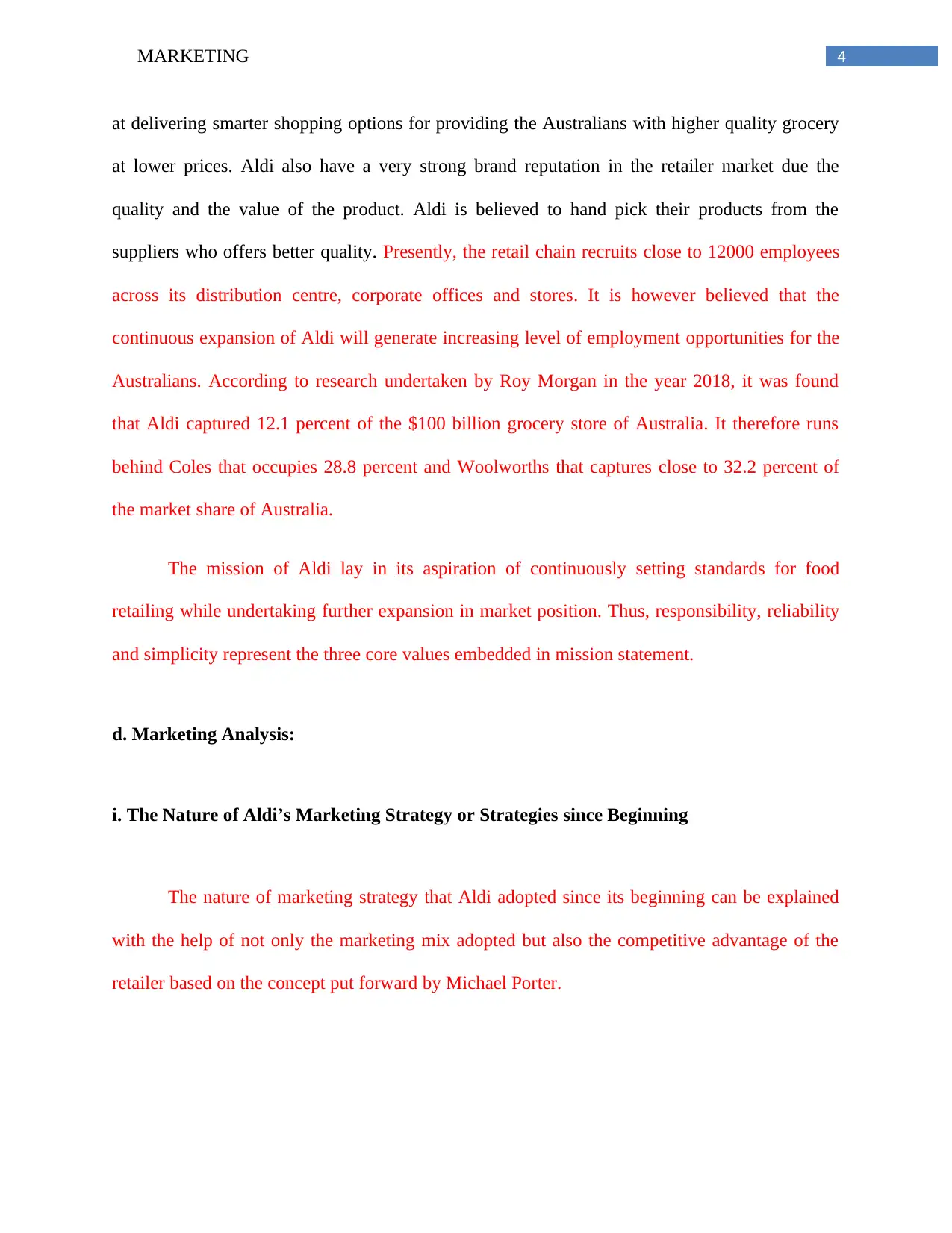
4MARKETING
at delivering smarter shopping options for providing the Australians with higher quality grocery
at lower prices. Aldi also have a very strong brand reputation in the retailer market due the
quality and the value of the product. Aldi is believed to hand pick their products from the
suppliers who offers better quality. Presently, the retail chain recruits close to 12000 employees
across its distribution centre, corporate offices and stores. It is however believed that the
continuous expansion of Aldi will generate increasing level of employment opportunities for the
Australians. According to research undertaken by Roy Morgan in the year 2018, it was found
that Aldi captured 12.1 percent of the $100 billion grocery store of Australia. It therefore runs
behind Coles that occupies 28.8 percent and Woolworths that captures close to 32.2 percent of
the market share of Australia.
The mission of Aldi lay in its aspiration of continuously setting standards for food
retailing while undertaking further expansion in market position. Thus, responsibility, reliability
and simplicity represent the three core values embedded in mission statement.
d. Marketing Analysis:
i. The Nature of Aldi’s Marketing Strategy or Strategies since Beginning
The nature of marketing strategy that Aldi adopted since its beginning can be explained
with the help of not only the marketing mix adopted but also the competitive advantage of the
retailer based on the concept put forward by Michael Porter.
at delivering smarter shopping options for providing the Australians with higher quality grocery
at lower prices. Aldi also have a very strong brand reputation in the retailer market due the
quality and the value of the product. Aldi is believed to hand pick their products from the
suppliers who offers better quality. Presently, the retail chain recruits close to 12000 employees
across its distribution centre, corporate offices and stores. It is however believed that the
continuous expansion of Aldi will generate increasing level of employment opportunities for the
Australians. According to research undertaken by Roy Morgan in the year 2018, it was found
that Aldi captured 12.1 percent of the $100 billion grocery store of Australia. It therefore runs
behind Coles that occupies 28.8 percent and Woolworths that captures close to 32.2 percent of
the market share of Australia.
The mission of Aldi lay in its aspiration of continuously setting standards for food
retailing while undertaking further expansion in market position. Thus, responsibility, reliability
and simplicity represent the three core values embedded in mission statement.
d. Marketing Analysis:
i. The Nature of Aldi’s Marketing Strategy or Strategies since Beginning
The nature of marketing strategy that Aldi adopted since its beginning can be explained
with the help of not only the marketing mix adopted but also the competitive advantage of the
retailer based on the concept put forward by Michael Porter.
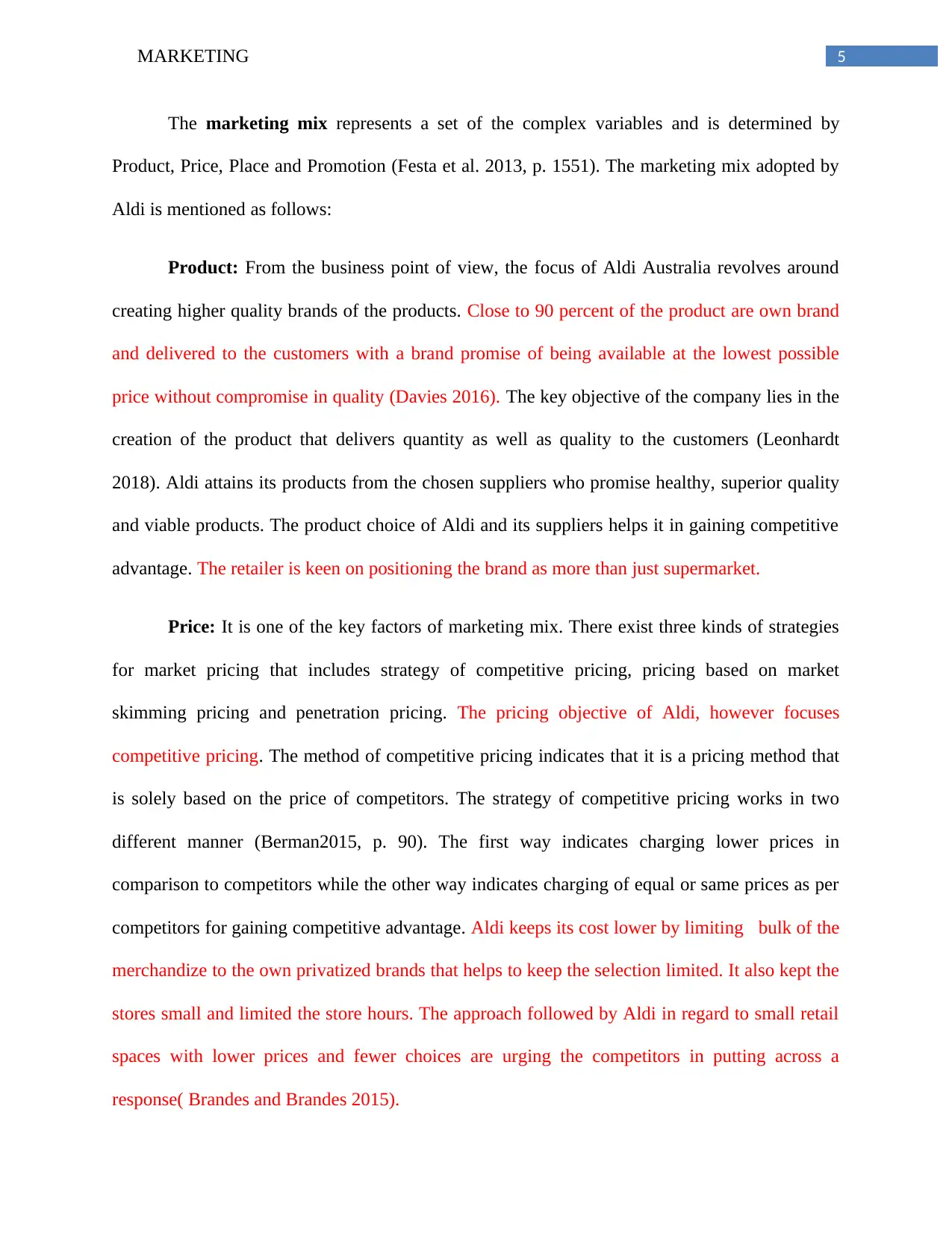
5MARKETING
The marketing mix represents a set of the complex variables and is determined by
Product, Price, Place and Promotion (Festa et al. 2013, p. 1551). The marketing mix adopted by
Aldi is mentioned as follows:
Product: From the business point of view, the focus of Aldi Australia revolves around
creating higher quality brands of the products. Close to 90 percent of the product are own brand
and delivered to the customers with a brand promise of being available at the lowest possible
price without compromise in quality (Davies 2016). The key objective of the company lies in the
creation of the product that delivers quantity as well as quality to the customers (Leonhardt
2018). Aldi attains its products from the chosen suppliers who promise healthy, superior quality
and viable products. The product choice of Aldi and its suppliers helps it in gaining competitive
advantage. The retailer is keen on positioning the brand as more than just supermarket.
Price: It is one of the key factors of marketing mix. There exist three kinds of strategies
for market pricing that includes strategy of competitive pricing, pricing based on market
skimming pricing and penetration pricing. The pricing objective of Aldi, however focuses
competitive pricing. The method of competitive pricing indicates that it is a pricing method that
is solely based on the price of competitors. The strategy of competitive pricing works in two
different manner (Berman2015, p. 90). The first way indicates charging lower prices in
comparison to competitors while the other way indicates charging of equal or same prices as per
competitors for gaining competitive advantage. Aldi keeps its cost lower by limiting bulk of the
merchandize to the own privatized brands that helps to keep the selection limited. It also kept the
stores small and limited the store hours. The approach followed by Aldi in regard to small retail
spaces with lower prices and fewer choices are urging the competitors in putting across a
response( Brandes and Brandes 2015).
The marketing mix represents a set of the complex variables and is determined by
Product, Price, Place and Promotion (Festa et al. 2013, p. 1551). The marketing mix adopted by
Aldi is mentioned as follows:
Product: From the business point of view, the focus of Aldi Australia revolves around
creating higher quality brands of the products. Close to 90 percent of the product are own brand
and delivered to the customers with a brand promise of being available at the lowest possible
price without compromise in quality (Davies 2016). The key objective of the company lies in the
creation of the product that delivers quantity as well as quality to the customers (Leonhardt
2018). Aldi attains its products from the chosen suppliers who promise healthy, superior quality
and viable products. The product choice of Aldi and its suppliers helps it in gaining competitive
advantage. The retailer is keen on positioning the brand as more than just supermarket.
Price: It is one of the key factors of marketing mix. There exist three kinds of strategies
for market pricing that includes strategy of competitive pricing, pricing based on market
skimming pricing and penetration pricing. The pricing objective of Aldi, however focuses
competitive pricing. The method of competitive pricing indicates that it is a pricing method that
is solely based on the price of competitors. The strategy of competitive pricing works in two
different manner (Berman2015, p. 90). The first way indicates charging lower prices in
comparison to competitors while the other way indicates charging of equal or same prices as per
competitors for gaining competitive advantage. Aldi keeps its cost lower by limiting bulk of the
merchandize to the own privatized brands that helps to keep the selection limited. It also kept the
stores small and limited the store hours. The approach followed by Aldi in regard to small retail
spaces with lower prices and fewer choices are urging the competitors in putting across a
response( Brandes and Brandes 2015).
⊘ This is a preview!⊘
Do you want full access?
Subscribe today to unlock all pages.

Trusted by 1+ million students worldwide
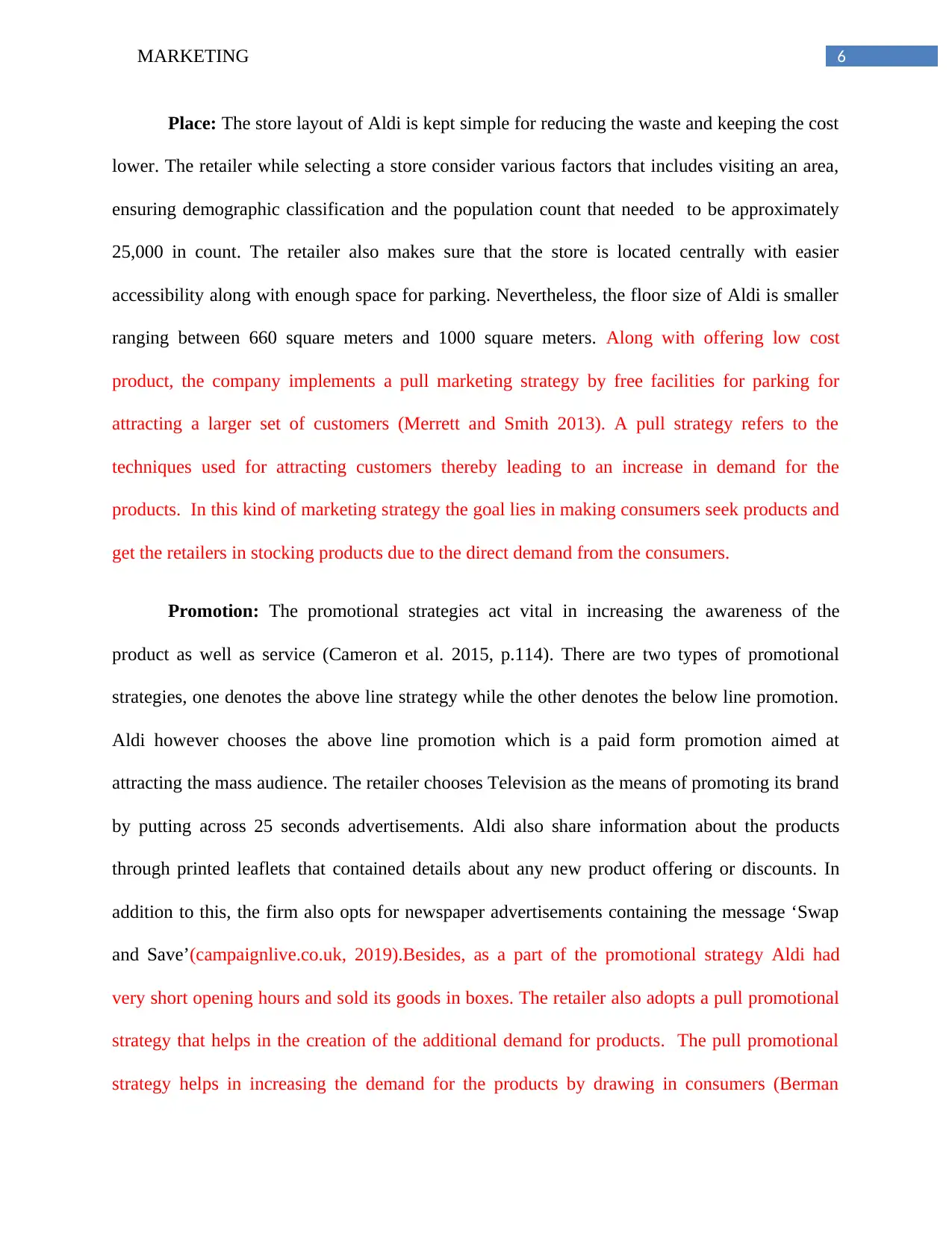
6MARKETING
Place: The store layout of Aldi is kept simple for reducing the waste and keeping the cost
lower. The retailer while selecting a store consider various factors that includes visiting an area,
ensuring demographic classification and the population count that needed to be approximately
25,000 in count. The retailer also makes sure that the store is located centrally with easier
accessibility along with enough space for parking. Nevertheless, the floor size of Aldi is smaller
ranging between 660 square meters and 1000 square meters. Along with offering low cost
product, the company implements a pull marketing strategy by free facilities for parking for
attracting a larger set of customers (Merrett and Smith 2013). A pull strategy refers to the
techniques used for attracting customers thereby leading to an increase in demand for the
products. In this kind of marketing strategy the goal lies in making consumers seek products and
get the retailers in stocking products due to the direct demand from the consumers.
Promotion: The promotional strategies act vital in increasing the awareness of the
product as well as service (Cameron et al. 2015, p.114). There are two types of promotional
strategies, one denotes the above line strategy while the other denotes the below line promotion.
Aldi however chooses the above line promotion which is a paid form promotion aimed at
attracting the mass audience. The retailer chooses Television as the means of promoting its brand
by putting across 25 seconds advertisements. Aldi also share information about the products
through printed leaflets that contained details about any new product offering or discounts. In
addition to this, the firm also opts for newspaper advertisements containing the message ‘Swap
and Save’(campaignlive.co.uk, 2019).Besides, as a part of the promotional strategy Aldi had
very short opening hours and sold its goods in boxes. The retailer also adopts a pull promotional
strategy that helps in the creation of the additional demand for products. The pull promotional
strategy helps in increasing the demand for the products by drawing in consumers (Berman
Place: The store layout of Aldi is kept simple for reducing the waste and keeping the cost
lower. The retailer while selecting a store consider various factors that includes visiting an area,
ensuring demographic classification and the population count that needed to be approximately
25,000 in count. The retailer also makes sure that the store is located centrally with easier
accessibility along with enough space for parking. Nevertheless, the floor size of Aldi is smaller
ranging between 660 square meters and 1000 square meters. Along with offering low cost
product, the company implements a pull marketing strategy by free facilities for parking for
attracting a larger set of customers (Merrett and Smith 2013). A pull strategy refers to the
techniques used for attracting customers thereby leading to an increase in demand for the
products. In this kind of marketing strategy the goal lies in making consumers seek products and
get the retailers in stocking products due to the direct demand from the consumers.
Promotion: The promotional strategies act vital in increasing the awareness of the
product as well as service (Cameron et al. 2015, p.114). There are two types of promotional
strategies, one denotes the above line strategy while the other denotes the below line promotion.
Aldi however chooses the above line promotion which is a paid form promotion aimed at
attracting the mass audience. The retailer chooses Television as the means of promoting its brand
by putting across 25 seconds advertisements. Aldi also share information about the products
through printed leaflets that contained details about any new product offering or discounts. In
addition to this, the firm also opts for newspaper advertisements containing the message ‘Swap
and Save’(campaignlive.co.uk, 2019).Besides, as a part of the promotional strategy Aldi had
very short opening hours and sold its goods in boxes. The retailer also adopts a pull promotional
strategy that helps in the creation of the additional demand for products. The pull promotional
strategy helps in increasing the demand for the products by drawing in consumers (Berman
Paraphrase This Document
Need a fresh take? Get an instant paraphrase of this document with our AI Paraphraser

7MARKETING
2016). These marketing strategies encourage the customer to want a specific product. The pull
strategy helps Aldi in establishing direct contact with the consumers’ thereby building loyalty.
The strategy also enables the company in having stronger bargaining power with the retailers and
the distributors along with a focus of creating product value and brand equity. The strategy also
enables Aldi in gaining a feedback on products.
The competitive advantage of Aldi based on the concept put forward by Michael Porter
is the cost leadership strategy. Thus particular strategy implies that the firm produces its product
at lowest possible cost and if price remains equivalent or more than average market price then it
earns profit (Van den Steen and Lane 2014). In this regard, it can be said that Aldi offers all its
products at lowers price possible. The retailer achieved it through minimizing the operational
cost by buying single line for particular brand that in turn left the consumers with minimum
choices. The retailer also tried to keep the transportation cost minimum by directly transferring
the goods to the store from the warehouse. This resulted in the reduction of the overall expenses.
Besides, the design of stores is also done in a very basic manner since the person
responsible for handling products are customers themselves. The retailer stores more of limited
amount of products which is a crucial factor in determining its competitive advantage in
comparison to its competitors. Aldi also introduced an efficient checkout system that ruled out
the pain of standing in long queue and additional staff members ( Evans 2017).
Hence, taking into consideration the factors it can be mentioned that Aldi represented low
cost producer and is thus able to offer the customers lower prices while earning the required
amount of profits. This also resulted in a competitive advantage of Aldi over the others.
2016). These marketing strategies encourage the customer to want a specific product. The pull
strategy helps Aldi in establishing direct contact with the consumers’ thereby building loyalty.
The strategy also enables the company in having stronger bargaining power with the retailers and
the distributors along with a focus of creating product value and brand equity. The strategy also
enables Aldi in gaining a feedback on products.
The competitive advantage of Aldi based on the concept put forward by Michael Porter
is the cost leadership strategy. Thus particular strategy implies that the firm produces its product
at lowest possible cost and if price remains equivalent or more than average market price then it
earns profit (Van den Steen and Lane 2014). In this regard, it can be said that Aldi offers all its
products at lowers price possible. The retailer achieved it through minimizing the operational
cost by buying single line for particular brand that in turn left the consumers with minimum
choices. The retailer also tried to keep the transportation cost minimum by directly transferring
the goods to the store from the warehouse. This resulted in the reduction of the overall expenses.
Besides, the design of stores is also done in a very basic manner since the person
responsible for handling products are customers themselves. The retailer stores more of limited
amount of products which is a crucial factor in determining its competitive advantage in
comparison to its competitors. Aldi also introduced an efficient checkout system that ruled out
the pain of standing in long queue and additional staff members ( Evans 2017).
Hence, taking into consideration the factors it can be mentioned that Aldi represented low
cost producer and is thus able to offer the customers lower prices while earning the required
amount of profits. This also resulted in a competitive advantage of Aldi over the others.

8MARKETING
Value Chain Analysis: This refers to the strategy tool that helps in analyzing the internal
activities of the firm. The goal lies in identifying the activities that seems most valuable. This
indicates the source of the cost or the differentiation advantage to a firm (Jenkins and
Williamson 2015). It also takes into account the activities that need an improvement for
providing the competitive advantage. In case of Aldi, the value chain analysis shows how the
company is able to outperform its competitors. According to Porter, the activities undertaken in
performing the value chain analysis are mentioned as follows:
i. Primary activities: The key objective of the primary activities lies in upholding the
competitive advantage with regard to the production and product delivery.
ii. Inbound logistics: These represent the activities of receiving and storing the materials
necessary for manufacturing a product. In this regard, it can be said that Aldi purchases bulk
materials for producing own brand name that not only is cost effective but also determines the
competitive advantage of the firm in the long run over the other competitors.
iii. Operations: This portrays the lifecycle of the products and the services. Aldi have
created their own brand level and hence they are able to receive repeat customers to the stores. It
can be said that the product life cycle of Aldi remains in growth stage due to its already
established recognition in comparison to the other competitors.
iv. Outbound Logistics: It deals with how produced goods reach the buyers. Aldi have its
own transport system for making the products available to the customers.
v. Sales and Marketing: It is solely concerned with how information about the product is
made available to the customers through sales and marketing. Sales and marketing strategy of
Value Chain Analysis: This refers to the strategy tool that helps in analyzing the internal
activities of the firm. The goal lies in identifying the activities that seems most valuable. This
indicates the source of the cost or the differentiation advantage to a firm (Jenkins and
Williamson 2015). It also takes into account the activities that need an improvement for
providing the competitive advantage. In case of Aldi, the value chain analysis shows how the
company is able to outperform its competitors. According to Porter, the activities undertaken in
performing the value chain analysis are mentioned as follows:
i. Primary activities: The key objective of the primary activities lies in upholding the
competitive advantage with regard to the production and product delivery.
ii. Inbound logistics: These represent the activities of receiving and storing the materials
necessary for manufacturing a product. In this regard, it can be said that Aldi purchases bulk
materials for producing own brand name that not only is cost effective but also determines the
competitive advantage of the firm in the long run over the other competitors.
iii. Operations: This portrays the lifecycle of the products and the services. Aldi have
created their own brand level and hence they are able to receive repeat customers to the stores. It
can be said that the product life cycle of Aldi remains in growth stage due to its already
established recognition in comparison to the other competitors.
iv. Outbound Logistics: It deals with how produced goods reach the buyers. Aldi have its
own transport system for making the products available to the customers.
v. Sales and Marketing: It is solely concerned with how information about the product is
made available to the customers through sales and marketing. Sales and marketing strategy of
⊘ This is a preview!⊘
Do you want full access?
Subscribe today to unlock all pages.

Trusted by 1+ million students worldwide
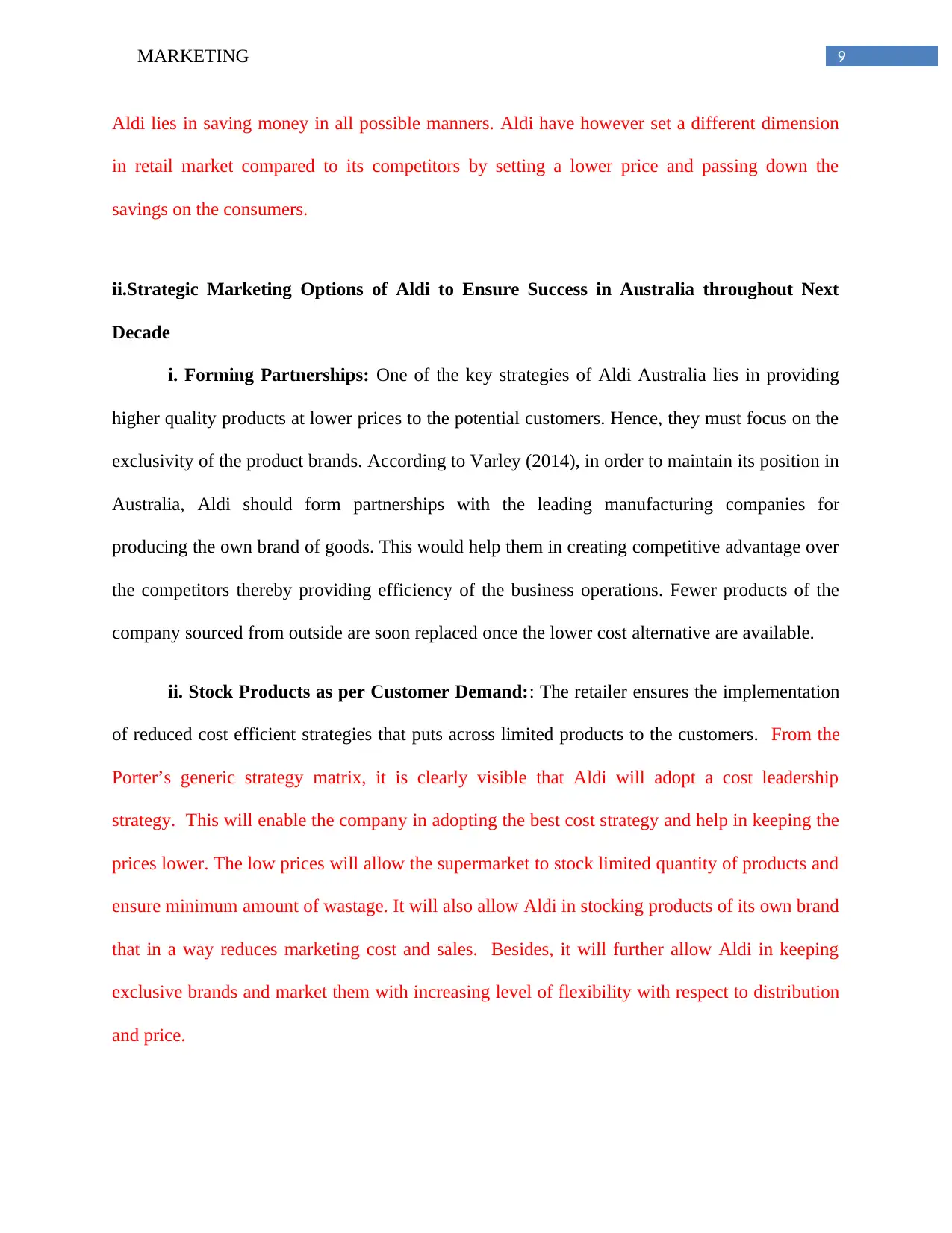
9MARKETING
Aldi lies in saving money in all possible manners. Aldi have however set a different dimension
in retail market compared to its competitors by setting a lower price and passing down the
savings on the consumers.
ii.Strategic Marketing Options of Aldi to Ensure Success in Australia throughout Next
Decade
i. Forming Partnerships: One of the key strategies of Aldi Australia lies in providing
higher quality products at lower prices to the potential customers. Hence, they must focus on the
exclusivity of the product brands. According to Varley (2014), in order to maintain its position in
Australia, Aldi should form partnerships with the leading manufacturing companies for
producing the own brand of goods. This would help them in creating competitive advantage over
the competitors thereby providing efficiency of the business operations. Fewer products of the
company sourced from outside are soon replaced once the lower cost alternative are available.
ii. Stock Products as per Customer Demand:: The retailer ensures the implementation
of reduced cost efficient strategies that puts across limited products to the customers. From the
Porter’s generic strategy matrix, it is clearly visible that Aldi will adopt a cost leadership
strategy. This will enable the company in adopting the best cost strategy and help in keeping the
prices lower. The low prices will allow the supermarket to stock limited quantity of products and
ensure minimum amount of wastage. It will also allow Aldi in stocking products of its own brand
that in a way reduces marketing cost and sales. Besides, it will further allow Aldi in keeping
exclusive brands and market them with increasing level of flexibility with respect to distribution
and price.
Aldi lies in saving money in all possible manners. Aldi have however set a different dimension
in retail market compared to its competitors by setting a lower price and passing down the
savings on the consumers.
ii.Strategic Marketing Options of Aldi to Ensure Success in Australia throughout Next
Decade
i. Forming Partnerships: One of the key strategies of Aldi Australia lies in providing
higher quality products at lower prices to the potential customers. Hence, they must focus on the
exclusivity of the product brands. According to Varley (2014), in order to maintain its position in
Australia, Aldi should form partnerships with the leading manufacturing companies for
producing the own brand of goods. This would help them in creating competitive advantage over
the competitors thereby providing efficiency of the business operations. Fewer products of the
company sourced from outside are soon replaced once the lower cost alternative are available.
ii. Stock Products as per Customer Demand:: The retailer ensures the implementation
of reduced cost efficient strategies that puts across limited products to the customers. From the
Porter’s generic strategy matrix, it is clearly visible that Aldi will adopt a cost leadership
strategy. This will enable the company in adopting the best cost strategy and help in keeping the
prices lower. The low prices will allow the supermarket to stock limited quantity of products and
ensure minimum amount of wastage. It will also allow Aldi in stocking products of its own brand
that in a way reduces marketing cost and sales. Besides, it will further allow Aldi in keeping
exclusive brands and market them with increasing level of flexibility with respect to distribution
and price.
Paraphrase This Document
Need a fresh take? Get an instant paraphrase of this document with our AI Paraphraser

10MARKETING
However, in order to ensure betterment of the product quality Aldi should select from the
customer product preferences and characteristics. Hence, Aldi must stock the products that have
a higher customer demand. To function successfully, Aldi should not only maintain a product
inventory but should successfully determine the variation, size and quality of the product. The
retailers should also opt for the suppliers who provided them with the right kind of product
without compromising on the taste and the quality at a reasonable rate (Ayersand
Odegaard2017). It has been found that, unlike the other supermarket chain, Aldi do not make
products of every size instead they make products of popular sizes which helps them in lowering
the stock size and maintaining the efficiency of the distribution within supermarket. Stocking of
single magnitude of product helps Aldi in reducing its cost (Tamm et al. 2015). In addition to
this, as a part of the environmental policy, Aldi remains committed towards the reusing, reducing
and recycling the waste and thereby increase energy efficiency. The retail chain also looks
forward toward decreasing the carbon footprint and implements the building of green standards
across all its stores and operations.
iii. Adoption of Diversification Strategy: The strong focus of Aldi should depend on its
core business which is the retail supermarket chain but it should also explore into the other retail
bases like the pharmaceuticals, petrol and liquor unlike the competitors. This would help the
retail chain to diversify. The ability to diversify will also allow the company in entering a newer
industry or market where the business does not operate presently. Diversification also aids in the
creation of the new product for the new market (Brandes and Brandes 2015).
iv. Bring About Changes in the Pricing Policy: It is to be noted that Aldi is one of the
first retailers in the industry that introduced lower pricing strategies to customers. However, to
remain successful in the market, Aldi should increase its price depending on the cost of the
However, in order to ensure betterment of the product quality Aldi should select from the
customer product preferences and characteristics. Hence, Aldi must stock the products that have
a higher customer demand. To function successfully, Aldi should not only maintain a product
inventory but should successfully determine the variation, size and quality of the product. The
retailers should also opt for the suppliers who provided them with the right kind of product
without compromising on the taste and the quality at a reasonable rate (Ayersand
Odegaard2017). It has been found that, unlike the other supermarket chain, Aldi do not make
products of every size instead they make products of popular sizes which helps them in lowering
the stock size and maintaining the efficiency of the distribution within supermarket. Stocking of
single magnitude of product helps Aldi in reducing its cost (Tamm et al. 2015). In addition to
this, as a part of the environmental policy, Aldi remains committed towards the reusing, reducing
and recycling the waste and thereby increase energy efficiency. The retail chain also looks
forward toward decreasing the carbon footprint and implements the building of green standards
across all its stores and operations.
iii. Adoption of Diversification Strategy: The strong focus of Aldi should depend on its
core business which is the retail supermarket chain but it should also explore into the other retail
bases like the pharmaceuticals, petrol and liquor unlike the competitors. This would help the
retail chain to diversify. The ability to diversify will also allow the company in entering a newer
industry or market where the business does not operate presently. Diversification also aids in the
creation of the new product for the new market (Brandes and Brandes 2015).
iv. Bring About Changes in the Pricing Policy: It is to be noted that Aldi is one of the
first retailers in the industry that introduced lower pricing strategies to customers. However, to
remain successful in the market, Aldi should increase its price depending on the cost of the
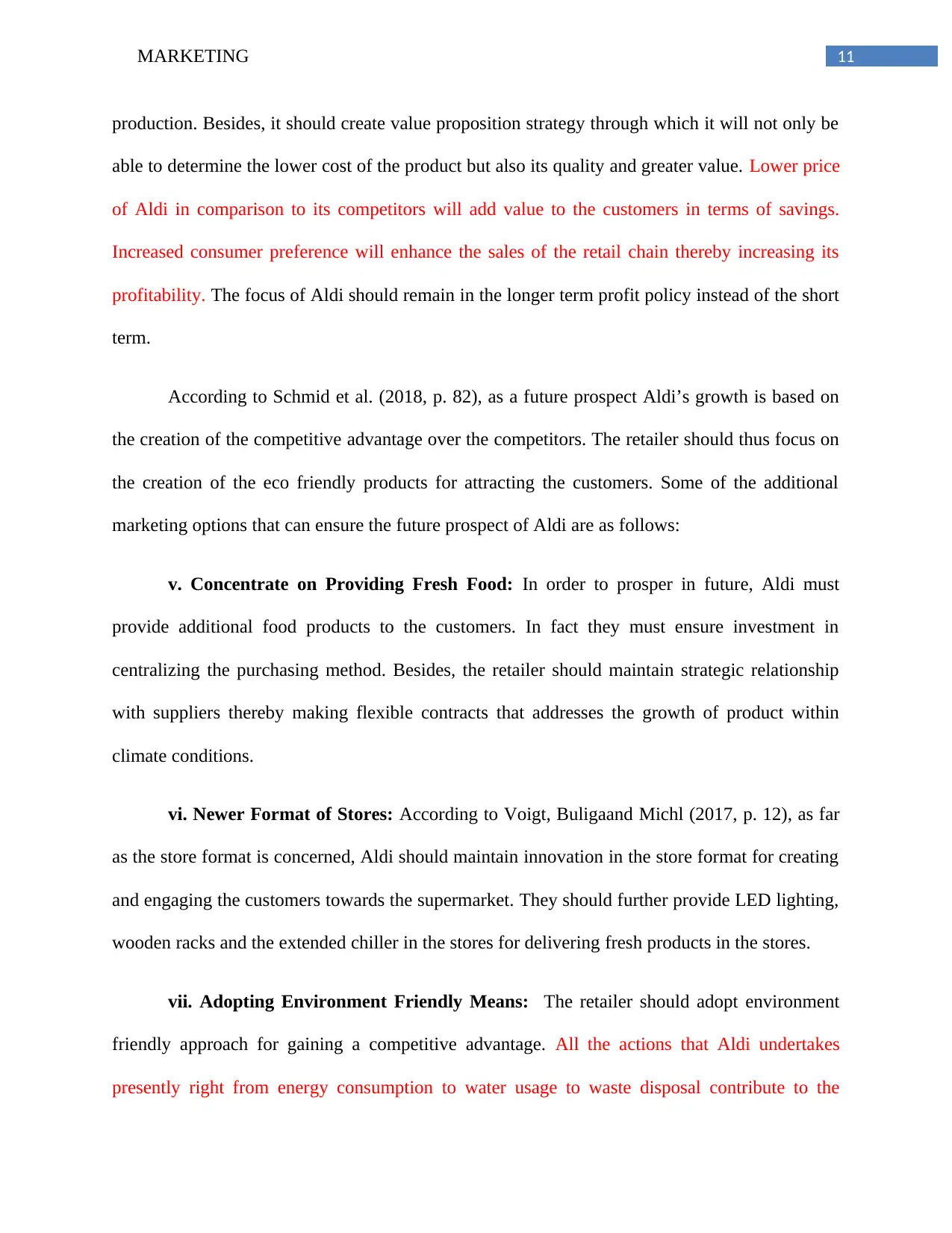
11MARKETING
production. Besides, it should create value proposition strategy through which it will not only be
able to determine the lower cost of the product but also its quality and greater value. Lower price
of Aldi in comparison to its competitors will add value to the customers in terms of savings.
Increased consumer preference will enhance the sales of the retail chain thereby increasing its
profitability. The focus of Aldi should remain in the longer term profit policy instead of the short
term.
According to Schmid et al. (2018, p. 82), as a future prospect Aldi’s growth is based on
the creation of the competitive advantage over the competitors. The retailer should thus focus on
the creation of the eco friendly products for attracting the customers. Some of the additional
marketing options that can ensure the future prospect of Aldi are as follows:
v. Concentrate on Providing Fresh Food: In order to prosper in future, Aldi must
provide additional food products to the customers. In fact they must ensure investment in
centralizing the purchasing method. Besides, the retailer should maintain strategic relationship
with suppliers thereby making flexible contracts that addresses the growth of product within
climate conditions.
vi. Newer Format of Stores: According to Voigt, Buligaand Michl (2017, p. 12), as far
as the store format is concerned, Aldi should maintain innovation in the store format for creating
and engaging the customers towards the supermarket. They should further provide LED lighting,
wooden racks and the extended chiller in the stores for delivering fresh products in the stores.
vii. Adopting Environment Friendly Means: The retailer should adopt environment
friendly approach for gaining a competitive advantage. All the actions that Aldi undertakes
presently right from energy consumption to water usage to waste disposal contribute to the
production. Besides, it should create value proposition strategy through which it will not only be
able to determine the lower cost of the product but also its quality and greater value. Lower price
of Aldi in comparison to its competitors will add value to the customers in terms of savings.
Increased consumer preference will enhance the sales of the retail chain thereby increasing its
profitability. The focus of Aldi should remain in the longer term profit policy instead of the short
term.
According to Schmid et al. (2018, p. 82), as a future prospect Aldi’s growth is based on
the creation of the competitive advantage over the competitors. The retailer should thus focus on
the creation of the eco friendly products for attracting the customers. Some of the additional
marketing options that can ensure the future prospect of Aldi are as follows:
v. Concentrate on Providing Fresh Food: In order to prosper in future, Aldi must
provide additional food products to the customers. In fact they must ensure investment in
centralizing the purchasing method. Besides, the retailer should maintain strategic relationship
with suppliers thereby making flexible contracts that addresses the growth of product within
climate conditions.
vi. Newer Format of Stores: According to Voigt, Buligaand Michl (2017, p. 12), as far
as the store format is concerned, Aldi should maintain innovation in the store format for creating
and engaging the customers towards the supermarket. They should further provide LED lighting,
wooden racks and the extended chiller in the stores for delivering fresh products in the stores.
vii. Adopting Environment Friendly Means: The retailer should adopt environment
friendly approach for gaining a competitive advantage. All the actions that Aldi undertakes
presently right from energy consumption to water usage to waste disposal contribute to the
⊘ This is a preview!⊘
Do you want full access?
Subscribe today to unlock all pages.

Trusted by 1+ million students worldwide
1 out of 16
Related Documents
Your All-in-One AI-Powered Toolkit for Academic Success.
+13062052269
info@desklib.com
Available 24*7 on WhatsApp / Email
![[object Object]](/_next/static/media/star-bottom.7253800d.svg)
Unlock your academic potential
Copyright © 2020–2025 A2Z Services. All Rights Reserved. Developed and managed by ZUCOL.





